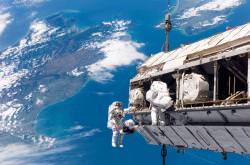Space station astronauts will conduct a spacewalk on January 30 to replace a faulty positioning motor at base of the station’s two starboard solar arrays. ISS Expedition 16 commander Peggy Whitson and flight engineer Dan Tani will change out the motor in hopes of regaining more power-generating ability of the orbiting laboratory’s expansive solar wings. But the astronauts will have to work fast, since they can only work on the electricity-producing arrays when the sun isn’t shining on them. That only allows 33 minute increments of time to conduct the repairs.
Because of the faulty motor, the solar arrays have been unable to track the sun continuously since early December, when the joint motor suffered a series of electrical shorts. In an earlier spacewalk, Tani and Whitson surveyed the damage and ruled out meteorite damage to the motor. Without the repair, the space station would have enough power to make it through at least the next shuttle mission, currently scheduled for a Feb. 7 launch, but not much further said Kirk Shireman, NASA’s ISS deputy program manager.
If the Wednesday spacewalk is successful, the ISS will have power to last through the planned arrival of a massive Japanese laboratory in April and into the summer, Shireman added.
The broken motor controls a beta gimbal joint that pivots one of the station’s two starboard solar wings to face the sun. NASA hopes replacing the whole motor, a garbage-can sized device that weighs about 250 pounds (113 kilograms), with a backup will fix the problem. The replacement motor was already on board the station, brought up on an earlier flight.
For safety reasons, the astronauts can only work while orbiting on the night side of Earth. If the sun was shining on the solar panels while Whitson and Tani were working on the joint, they would be at risk of shocks due to the high power levels surging through the arrays. They will only have about 33 minutes of total “shadeâ€? at a time to conduct their work. If they can’t replace the motor during one night side pass, they’ll have to wait and finish their task on the next pass. The station continuously orbits the Earth every 90 minutes.
NASA officials said the repair is possible to do in one 33 minute segment, but only if everything goes as planned. Since the damage only occurred recently, Whitson and Tani have not rehearsed the spacewalk in the Neutral Buoyancy Lab in Houston, a giant swimming pool where astronauts train for spacewalks. However, other astronauts on the ground have rehearsed the repair and shared their insights with the astronauts on board the ISS.
Wednesday’s EVA will be the sixth career spacewalk for both Whitson and Tani, and the fifth for the station’s Expedition 16 crew.
This spacewalk is unrelated to on-going analysis of problems with a massive Solar Alpha Rotary joint on the right side of the station’s main power truss that is needed to turn outboard arrays to track the sun. Astronauts discovered metal shavings in the gear’s attached metal ring during past spacewalks, and engineers do not yet understand the cause of the unusual erosion. Whitson and Tani will take another look at the 10-foot (3-meter) wide gear if they have extra time during Wednesday’s excursion, mission managers said.
NASA will broadcast the Expedition 16 crew’s fifth spacewalk live on NASA TV beginning at 4:00 a.m. EST (0900 GMT) on Jan. 30.
Original News Source: NASA TV, Space.com


Good luck to the astronauts on this exciting and important spacewalk!
I don’t think that the politicians and public have any idea of the amazing accomplishments that the astronauts accomplish every day. If they did, then NASA would have more support financially in the congress and more public enthusiasm.
This station crew has done an amazing job so far perfoming a good number of unanticipated spacewalks & repairs to repair the solar arrays. I think this speaks volumes for the training these astornauts receive in preparation. Keep up the good work!
Good Luck. This crew will do another another great job.Very proud of them as all of us are.
good luck!
Amazing feat and picture… reminds me of the old pictures you used to see of the iron workers constructing skyscrapers in the early 1900s – what a difference a century makes!
Good luck to all concerned